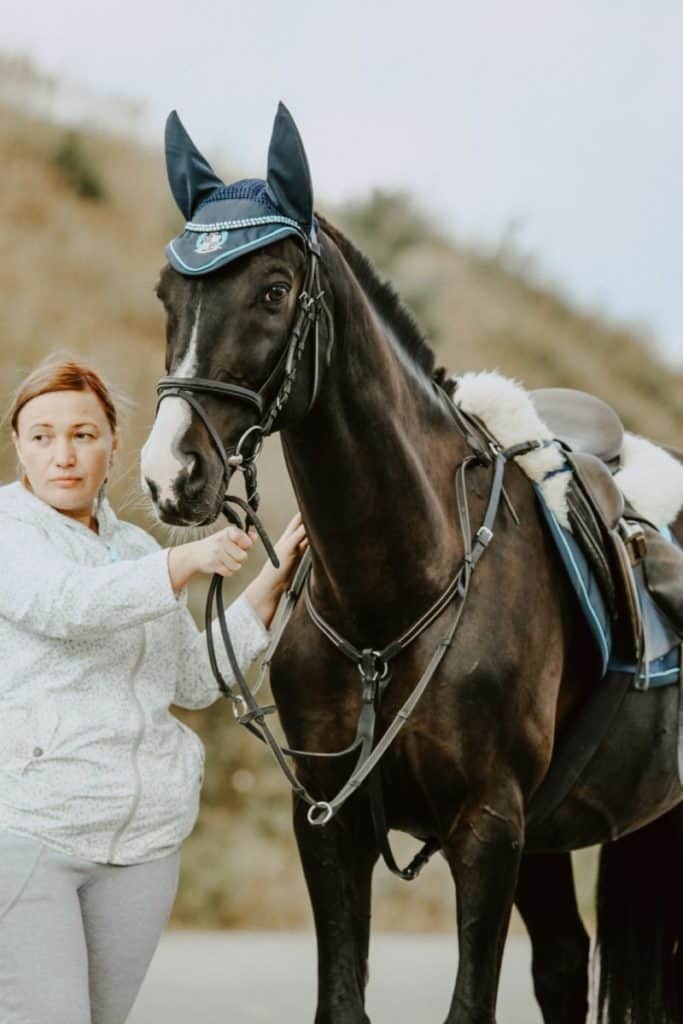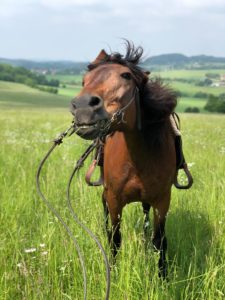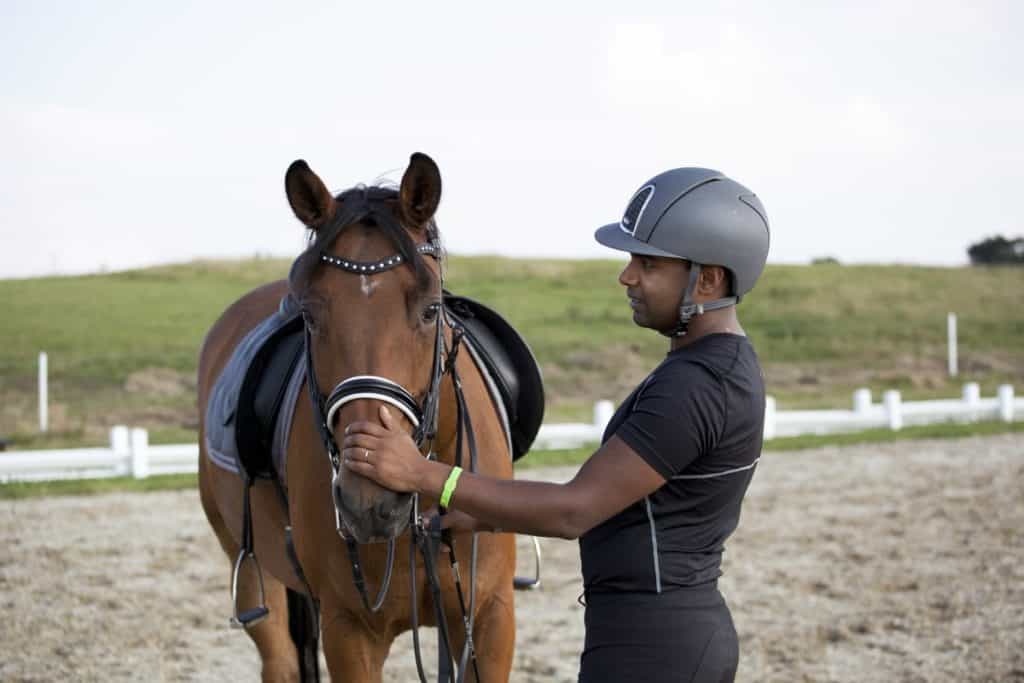
We’ve all been there; You’re out on a trail ride and need to dismount to open a gate. Maybe you’ve dropped something or worse still, taken a tumble. It happens to the best of us. Whatever the reason, you’re left wondering how on earth do you get back on your horse without a mounting block?
Whilst it’s not a good idea to mount from the ground unless you absolutely have to, here are some key steps to follow when you do.
- Check your girth. It’s important to know that your saddle isn’t going to slip when you put your weight into the stirrup. It should be snug, but not so tight it’s uncomfortable for your horse.
- Lower your stirrup. If you find it hard to reach with your foot, then lower it a couple of holes to make it easier.
- Ensure your horse is standing square. You want him to be as balanced as possible in preparation for you mounting.
- Stand close to your horse. You don’t want to have to travel horizontally as well as vertically.
- Gather the reins in your left hand. Not too short, but enough to have some light contact with your horse’s mouth.
- Keep the reins steady. Rest your left hand at the base of the mane or on the pommel (at the front) of the saddle for support
- Prepare. Place your left foot in the stirrup, pointed towards the girth to avoid any unintentional signals to your horse. Place your right hand over the far side of the saddle cantle (at the back).
- One bounce and up. Bend your right leg as much as possible, push off it while you press down in the stirrup with the left foot and propel yourself up and over. If you need a couple of mini bounces to get some momentum, that’s ok, but try to avoid pressing into the stirrup until your final bounce.
- Land gently. As you swing your right leg clear of your horse’s hindquarters, move your right hand over to the front right of the saddle and support your weight while you gently lower yourself into position.
It’s important to remember that mounting from the ground puts a great deal of strain on your horse’s back. It can also be risky for you if your horse is spooked and moves suddenly while you are trying to get on.
You’ll want to make it easier and safer wherever possible, so here are some other tips for getting on a horse without a mounting block.
Ask Someone for Help
Ask someone to give you a leg up. You get the benefit of their propulsion as well as your own, so it should make things easier for you and more comfortable for your horse. Everything in terms of hand positions and landing remains the same.
Don’t attempt this if you are significantly heavier than your helper, or if you haven’t tried it before as it could put a strain on their back or have you both landing in a heap on the ground!
Alternatively, you can also get a helper to simply push down on the stirrup on the other side of the saddle. This will provide counter-balance when you press down in the stirrup, meaning the saddle is less likely to slip and your horse can remain square.
If you are a practiced ground-mounter but have a flighty horse, you might want to ask your helper to simply hold your horse steady as you get on.
Use Elements in Your Environment
If you don’t have access to a mounting block, you might be able to find other ways to even out the height difference between you and your horse.
Tree stumps, flat rocks and steps (of a building, for example) all make great makeshift mounting aids. Just be sure to assess the safety of whatever you are using. Think about where you might end up if your horse moves while you are trying to get on him.

Finding higher ground can also be an option. If you are out riding somewhere with undulating ground, you can use this to your advantage by positioning your horse in a dip while you mount from level ground, or by standing a little way up a hill with your horse on the level ground. Again, ensure that your horse is able to stand squarely and that you are not forcing him off balance, and also that you are able to safely land if you don’t manage to mount successfully the first time.
If your horse isn’t very good at standing still, or if there are high winds or loud noises, you might want to think about using any fences or hills to position him in a way that protects you both or discourages him from walking away from you.
Practice in the Yard

Whilst you don’t want to make a habit of getting on without your mounting block, it’s worth practicing every now and again just so that you are prepared – a bit like a fire drill.
Make sure you go over it step by step, to help you get used to the process. It’s also important that your horse understands what’s going on, so he doesn’t feel like there’s cause for concern if you have to use the technique unexpectedly.
One of the best preparations you can make is to train your horse to stand still as you mount. This can take time and patience but will pay off in the end for both of you. One step further, and you can also teach him to maneuver himself next to whatever you are mounting from. This is useful in the yard anyway, but nothing short of priceless if you are having to stand on a tree stump or awkward hill.
Richard Maxwell is an excellent resource on this subject. Here is a training demonstration from him where you can definitely pick up some tips.
Be as Fit as You Can Be
As horse riders, most of us are relatively fit and active but there is always room for improvement. Exercises on the ground are an essential part of maintaining and improving fitness in the saddle, leading to a better riding experience for both you and your horse. Mounting is no exception and there are some specific stretches you can do which will give you better flexibility and therefore improve your ability to get on a horse without a mounting block.
Any exercises which gently stretch your hamstrings or improve your hip flexor flexibility will give you a greater range of movement, which can only help when it comes to getting on your horse.
Why now try our 5-minute stretching program on YouTube:
However, regardless of the tips you choose to employ, it’s vital for both you and your horse that you make mounting as swift and smooth as it can be, for many reasons.
Less Chance of Injury
When you put your entire body weight into the stirrup during mounting, your horse experiences much more pressure on his back than when you are seated and riding. Add to this, the torque (twist) created by the movement of the saddle itself as you mount, and he has to go through quite a lot before you’re even up there.
Repeatedly mounting from the ground, especially if it is done clumsily or your horse moves away from you, leaving you scrambling up his side, is going to increase the chances of him developing a back injury.
Training him to stand still, improving your own fitness, using an object or the landscape to decrease the distance you need to travel to hike yourself up and over, getting a leg up / stirrup hold from a helper; these are all great ways for you to protect his back from injury, as well as lessen your own chances of having an accident.
Increased Harmony
A ride that starts out calmly and drama-free is set up for success. You will be more aware of your surroundings (instead of trying to calm down from a stressful mount), and your horse will be better able to concentrate on the job at hand and listening to the signals you are giving him.
Less Worries
We all ride because we enjoy it. The last thing we want is to spend time worrying about not being able to get back on if we need to.
Preparing yourself and your horse by following the steps in this guide, will leave you both feeling comfortable and confident that you can get on without a mounting block, wherever you are. So, whether you’re out trail riding and enjoying the scenery, in competition or schooling at home, you’ll be able to focus on your ride and have fun.


